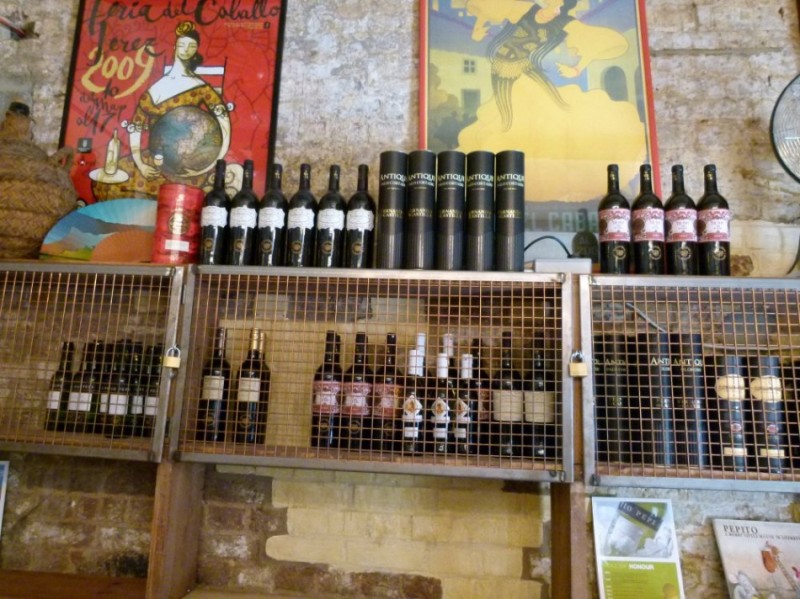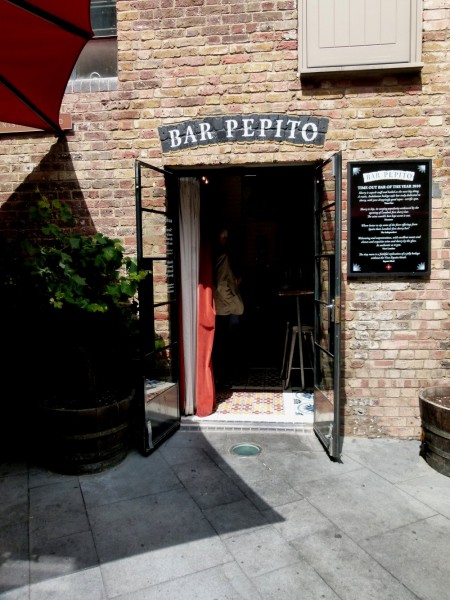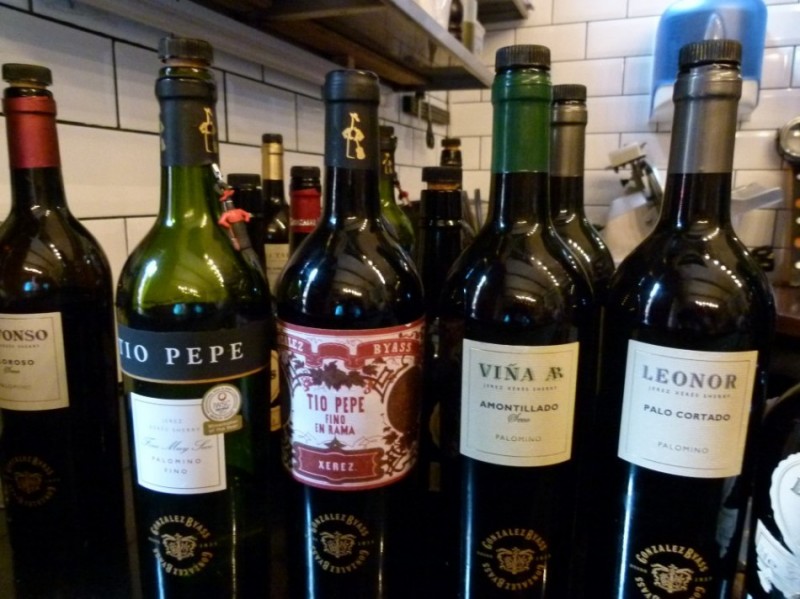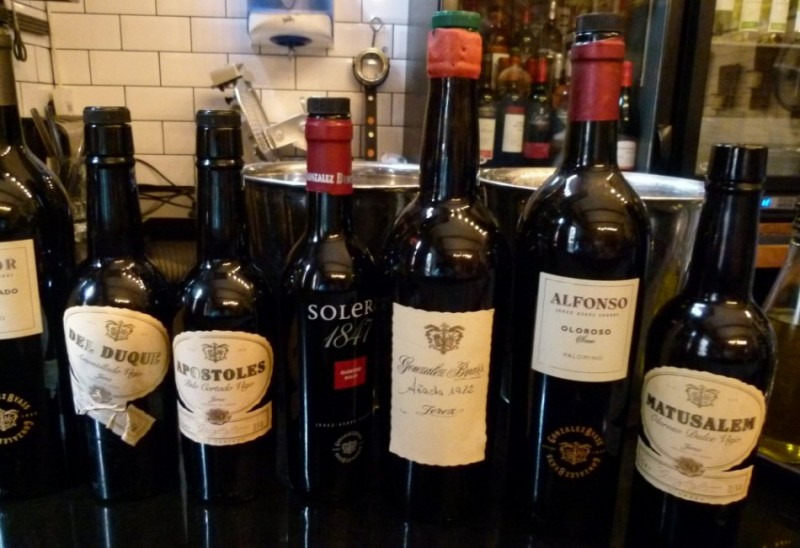I had just attended an exceptional Master of Wine seminar run by Gonzalez Byass on the role of yeast and oxygen in sherry-making so why bother go to another sherry event? Well, I knew this AWE event would have a different feel and tempo, being held at Bar Pepito in Kings Cross, and I would get the chance to try some fabulous sherries again.
Jeremy Rockett, marketing director for Gonzalez Byass, has a friendly and relaxed delivery. He took us through a range of 12 sherries: Tio Pepe Fino and the much talked about Tio Pepe En Rama Fino, two fascinating Amontillados, 2 Palo Cortados, 3 Olorosos and 2 unctuous Pedro Ximenez of different intensities. We also had a taste of the mosto before it becomes sherry. All this was followed by some delicious light tapas.
I had especially requested that we taste the mosto. I remember being taught at the WSET that the Palomino Fino grape produced a very neutral wine which was therefore suitable for fortification and to be made into sherry. I was therefore surprised at the MW seminar how aromatic the mosto is, with aromas and flavours of honey and overripe apples. This tallied with my experience of a dry PX from M&S I had recently tasted. It was equally aromatic and flavoursome.
Tio Pepe
Tio Pepe is made from 3 soleras known by the initials A, B and C and comprising 30,000 barrels. Only the free-run juice is used for Fino, whereas the lightly pressed juice is used for Oloroso. A further pressing goes to make ‘Le Panto’ Brandy de Jerez – the only brandy which is distilled from Palomino.
Tio Pepe is also fermented at lower temperatures than other styles. The yeast comes from the grape skins and is initially anaerobic but as it floats to the top it becomes aerobic. It starts to consume vitamins, amino acids, proteins and glycerol making the wine taste drier. It was very interesting to compare the 2010 mosto: it tasted much richer and had almost off-dry impression.
If you look at the technical data (see table) it has 1.5g of residual sugar and 7.5 g/l glycerol while only 60 mg/l acetaldehyde. The finished Tio Pepe tasted much drier, more severe and the tanginess and flavours of sea salt and brine-soaked apples was emphasised. (Fino stats : < 1 rs, 0.5 g/l glycerol and 350 mg/l acetaldehyde).
| Age | ABV | Residual Sugar g/l | Total Acidity g/l | Glycerol g/l | Acetaldehyde mg/l |
| 2010 vintage | 12.3% | 1.5 | 5 | 7.5 | 60 |
| 4-5 years | 15.0% | <1 | 4 | 0.5 | 350 |
| 4-5 years | 15.0% | <1 | 4 | 0.5 | 350 |
| 10 years | 16.0% | <4 | 4 | 0.8 | 393 |
| 30 years | 21.5% | 5 | 4.7 | 1 | 418 |
| 12 years | 20.0% | 8 | 4.3 | 5 | 92 |
| 1982 vintage | 20.5% | 8.5 | 4.1 | 7.2 | 98 |
| 30 years | 20.0% | 60 | 6.2 | 8.1 | 76 |
| 10 years | 18.0% | <4 | 5 | 7.5 | 40 |
| 10 years | 18.0% | 127 | 5.7 | 9.2 | 40 |
| 30 years | 20.5% | 137 | 6.2 | 11 | |
| 10 years | 15.5% | 370 | 2.9 | 2.5 | |
| 30 years | 15.5% | >400 | 5.3 | 4 |
Now interestingly, the Tio Pepe En Rama had exactly the same statistics as the Tio Pepe but tasted completely different. The colour was a little deeper and more golden and there was an added dimension of a slight waft of honey, together with the sea salt notes on the nose. The texture was much richer as if there was more glycerol on the palate, although the technical details say that there isn’t. There was also a slight softness, with honeyed flavours balancing the drier briney flavours. It was altogether a more interesting and complete wine and I scored it 94/100 whereas the standard Tio Pepe scored 88/100.
Jeremy told us that the term ‘En Rama’ has come to mean ‘raw’ or ‘raw state’ but its literal meaning is a twig covered in flor. The flor is thickest in spring and autumn and the wine is taken from the middle of the cask and put into stainless steel. The normal process for Tio Pepe would be to put it through a coarse filter, fine with bentonite, cold stabilise to remove tartrates then micro-filter and bottle using nitrogen; whereas Tio Pepe Fino En Rama has had no fining, no filtration and no clarification. This has a huge impact on the bottling line and the wine is more expensive to produce. Jeremy described it as ‘Tio Pepe turbo-charged’. They have only made 350 dozen bottles this year and most appear to have been sold already. I can easily see why – it is so much more complete and complex in style.
Between the mosto (first wine tasted) and the Tio Pepe (2nd wine tasted) there are 4½ years of maturation. Looking at the technical details this corresponds to a reduction from 7.5 g/l to 0.5 g/l glycerol, a reduction from 1.5 g/l rs to less than 1.00 g/l rs and an increase in acetaldehyde from 60 mg/l to 350 mg/l.
Amontillados
The tasting continued with and exciting pair of Amontillados and probably my highlight of the tasting which was the Del Duque 30 year old Amontillado – Amber with red-gold tones in appearance, very intense nose with rich treacle toffee, sultanas and brown sugar aromas and flavours (and an intriguing note of fish oil). Very, very long and tangy and incisive. 94/100
Once again if we look at the statistics, this one had the highest overall acetaldehyde but also 5 g/l rs, one of the higher acidities at 4.7 g/l and a glycerol of 1 g/l. I love the balance of this wine and the intricate play of aromas and flavours.
The Amontillados were followed by three contrasting Palo Cortados. I was told by Miguel Valdespino many years ago that Palo Cortado was a naturally occurring accident with a wine that started life as a Fino but wanted to be an Oloroso. This is the style I have always sought and I believed it to be a genuine expression. However because of the prestige and cachet of the wine, not to mention the price tag, some producers seem to take liberties with the true Palo Cortado syle. For me, the Gonzalez Byass Apostoles falls into this category because it has some PX in it. It is a fabulous wine but I wish they wouldn’t call it a Palo Cortado. Jeremy said there was a lot of discussion within the company about whether to change the name, as the brand name and quality were probably strong enough to exist on their own.
We were also given the rare privilege of tasting an extra wine kindly brought by Jeremy – a 1982 Palo Cortado. This rare ‘vintage’ sherry was from a special barrel and had had one filtration. It sells for £70 a bottle. This was exciting to taste but had a slightly lifted balsamic note as well as warm sultana and toffee aromas. It had the impression of being quite dry although technically it wasn’t. Tangy, treacle toffee and burnt toffee flavours. Elegant, nervy with some almost Maderia-like flavours. Very interesting. 94/100
Having tasted an interesting trio of Olorosos in a range of styles, including the very-deservedly famous Matusalem 30 year old Oloroso Dulce (£16.49 – 37.5cl), we moved on to two amazingly unctuous and rich PX’s – Nectar PX (£11.99) and Noe 30 year old PX £16.49 (37.5cl). Both were impressive wines and I gave them both above 90 marks with a 95 for the 30 year old.
I raised the question of putting the date of bottling on the Finos so that consumers would know how long the sherry had been kept on shelves. Jeremy said they were looking into this but of course there would be potentially huge issues if retailers and restaurants wanted to return old stock having failed to sell at the appropriate time. If there was a way to do this which offered Gonzalez Byass some protection I feel this would be a great initiative and a big step forward towards being able to enjoy sherry at its best.
Many thanks to Jeremy Rockett, Louise Bartholdi and all at Gonzalez Byass for an excellent and well-attended seminar, to Linda Simpson for organising it on behalf of the AWE and to the staff at Bar Pepito for some delicious tapas.
P.S. Jeremy gave us an anecdotal way to determine the correct food pairing with sherry:
If it swims, drink Fino,
If it flys, drink Amontillado,
If it runs, drink Oloroso.
Wines tasted:
Tio Pepe – Fino £9.99, Tio Pepe En Rama – Fino En Rama £11.99, Viña AB – Amontillado £11.99, Del Duque – 30 year old Amontillado £16.49 (37.5cl), Leonor – Palo Cortado £11.99, Apostoles – 30 year old Palo Cortado £16.49 (37.5cl), Alfonso – Oloroso Seco £11.99, Solera 1847 – Oloroso Dulce £11.99, Matusalem 30 year old Oloroso Dulce £16.49 (37.5cl), Nectar – PX £11.99, Noe 30 year old PX £16.49 (37.5cl)
© 2011 – 2012, Susan Hulme MW. All rights reserved.




